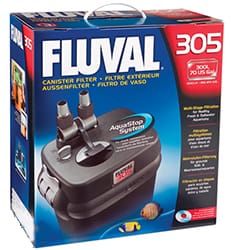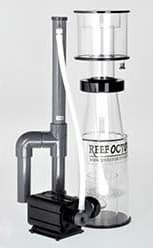Aquarists converting from freshwater to saltwater seem to think that a Canister Filter is the ultimate in filtration for their saltwater aquarium. They have most likely gotten this idea because it is usually the most expensive aquarium filter at most fish stores and considered the best in freshwater aquarium filtration. In reality, a Canister Filter is the best choice for every aquarium.
Buying a Canister Filter
Although Canister Filters make excellent filters for most freshwater aquariums, they use the same filtration concept as conventional hang on the back cartridge filters. In a head to head comparison, the largest Canister Filters and hang on the back filters provide the same flow rate, approximately 300-500 gallons per hour. Canister Filters provide a slight edge in size as they are able to hold more media and filters. Unfortunately, sponges in canister filters and hang on the back filters trap waste in the filter and your aquarium’s water runs through it while bacteria break down the waste. One advantage to Canister Filters is they can be hidden inside the aquarium’s stand, which allows the aquarium to be pushed nearly flush against a wall, whereas a hang on back filter requires a around six inches of room between the wall and the aquarium.

If you answer “Yes” to all of these statements, a Canister Filter may be the best choice for your saltwater aquarium:
1. My aquarium is less than 40 gallons.
2. It is important that my aquarium sit almost flush against the wall.
3. I plan on keeping only a few fish and have little interest in invertebrates and corals.
If you answered “No” to any of the statements, a Canister Filter is probably not the best choice for your aquarium.
Selecting a Canister Filter
1. If your aquarium is less than 55 gallons and it is not important that your aquarium sits flush against the wall, you may be able to use a similar size hang on the back filter rather than a Canister Filter. Aquarists wanting to use a Canister Filter pay around an extra $100 for the convenience of being able to hide the filter inside the stand.
2. Aquarists seeking to keep a large number of fish, corals and invertebrates will need more filtration than a Canister Filter or hang on the back filter can typically provide. Hobbyists with an aquarium less than 30 gallons should consider a Hang on Back Protein Skimmer The advantage of a HOB Protein Skimmer is it removes the physical waste from the aquarium, rather than trapping it in a cartridge where it breaks down and releases ammonia and nitrate.

3. Aquariums greater than 55 gallons should consider an In Sump Protein Skimmer as the primary filter. This can also be used in combination with a Refugium or Wet/Dry Filter if the principles of each filter are applied correctly. Please remember to avoid Hang on the Back Overflow Boxes as they will fail and eventually ruin your floor.
4. If you own an aquarium larger than 55 gallons and your tank is not pre-drilled with holes, also known as reef ready, than you are in a difficult situation. Your options include drilling your current aquarium, purchasing a new reef ready aquarium, purchasing multiple or very large hang on the back protein skimmers, or limiting yourself to less livestock. As the aquarium size increases it will become increasingly more difficult to maintain ideal water parameters without weekly water changes.
A Canister Filter makes sense for only a few applications, as a hang on the back filter can provide the same efficiency of filtration for less money. The Canister Filter is definitely not the ultimate in saltwater aquarium filtration; instead a hang on the back or in sump protein skimmer will provide better filtration and can be combined with a refugium or wet/dry filter. Although there are many debates about if a protein skimmer is really necessary, for the average hobbyist will find that it greatly reduces maintenance. When selecting a protein skimmer, purchase the best your budget can afford, so that you don’t have to upgrade later.
